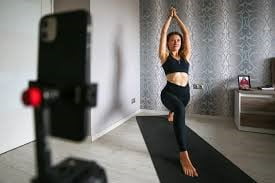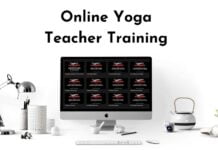There are so many things you could be doing to market your online yoga business.
But as entrepreneurs, it’s important to focus your energy on what really works for your business. Every platform isn’t going to be right for everyone. Try youtube to market your business as a yoga instructor!
Yoga Alliance, the largest credentialing organization for yoga schools and teachers, does not validate online yoga teaching in its current guidelines, says Christa Kuberry, the nonprofit’s vice president of standards. But this might change, as the institution is going through a standards review project. “Ideally, yoga should be learned in person, which is the preferred method for several reasons, including safety,” says Auberry. “But what is wonderful about the online experience is accessibility.”
This article will share how to decide if YouTube is right for your yoga business and how to get started with YouTube if it is.
Why YouTube?
Great question. Here are some of the benefits of using YouTube for your yoga business:
- YouTube has an incredibly large audience— almost a third of all people on the internet (Source). In fact, according to Nielsen, YouTube reaches more US adults aged 18-34 than any cable network.
- YouTube can help with your SEO. First of all, hosting video content on YouTube keeps your site lighter and faster, which helps with SEO. Secondly, your YouTube videos could show up in Google search (YouTube is owned by Google) with the right keywords. I’ll dive into that a little more below!
- YouTube content is easily shareable. With a few clicks and your videos can reach a whole new audience of viewers.
- If your YouTube channel gets big enough, you may be able to make money from ads on your videos. This year, YouTube announced new requirements for monetization. Once your channel reached 4,000 watch hours in the previous 12 months and 1,000 subscribers, you’re eligible to join the monetization program.
There are plenty of pros to being on YouTube. But with all of that being said, there are a few questions to ask to decide if YouTube is right for you.
Although the effectiveness of YouTube yoga has not yet been deeply investigated, some of the existing yoga research can provide insights into how to best conduct your home practice. Here are a few takeaways.
Aim for high frequency

It’s hard to determine exactly how much yoga is enough to obtain health benefits. But one of Greenberg’s studies found that people prescribed the highest amount of yoga home practice, four hours per week, achieved significant stress reduction, even if their level of compliance was lower than the groups with lighter prescriptions of two-and-a-half hours and one hour weekly. But it is possible to go overboard and end up discouraged, Greenberg says. Forty minutes a day is a good target, he says, but if a person can only get in 25 minutes daily, that is still good.
Create a dedicated yoga space
The lack of an adequate space to practice yoga at home was mentioned as the reason why a few people skipped a few classes in Gomes’ virtual yoga study. The researcher says that always practicing in the same spot, preferably in a quiet and private room, helps to establish a routine.
While distractions may be abundant at home, yoga studios tend to be viewed as sacred, purpose-driven places, says Park. “Whenever you walk into a yoga studio, you have immediate relaxation. That has a lot to do with the environment, the right kind of music, [and] light.” If a person can reproduce this sort of environment at home, she suggests the calming effect could potentially be enjoyed beyond yoga time.
An occasional in-person class may help you stay on track
Even if a yoga video tutorial manages to be thoroughly explanatory, not every practitioner has the same level of body awareness and, for some, the presence of a teacher is needed. Scheduling an in-person yoga class now and then can be a good complement to the YouTube sessions. Park says that even though she’s been practicing yoga for 15 years, teachers still point out when she is being “lazy” in certain postures. “It would be important to go to occasional live classes to get those reminders,” she says.
Learn how to prevent injuries
Cramer and his team found that the main risk factor for yoga-related injuries is unsupervised yoga practice at home. “This is not surprising because no feedback is provided on whether yoga exercises and breathing techniques are executed correctly,” he says. “If done wrong for a prolonged time, these exercises can be harmful.”
It’s important for inexperienced yogis venturing into online tutorials to avoid difficult inversion poses, such as the headstand. “When practicing yoga at home, keep in mind the concept of ahimsa, which means nonviolence,” says Gomes. “Respect the limits of your body and notice if a posture does not feel right.”
Having confidence in your ability to do it is a predictor of success

Finding motivation might be extra challenging for YouTube yoga practitioners. It is well known that group accountability can increase adherence to health behaviors since groups raise the pressure as well as motivation, says Cramer. “There most likely is a higher risk of non-adherence without a supporting group and yoga teacher or therapist,” he says.
In his yoga studies, Greenberg has found two variables that predicted the degree to which participants would stick to the program: self-control and self-efficacy, which is the individual’s belief in his or her ability to do it.
People who are confident and believe they can succeed are the ones who must comply with the practices
Join Our Yoga Teacher Training And Main Event







































